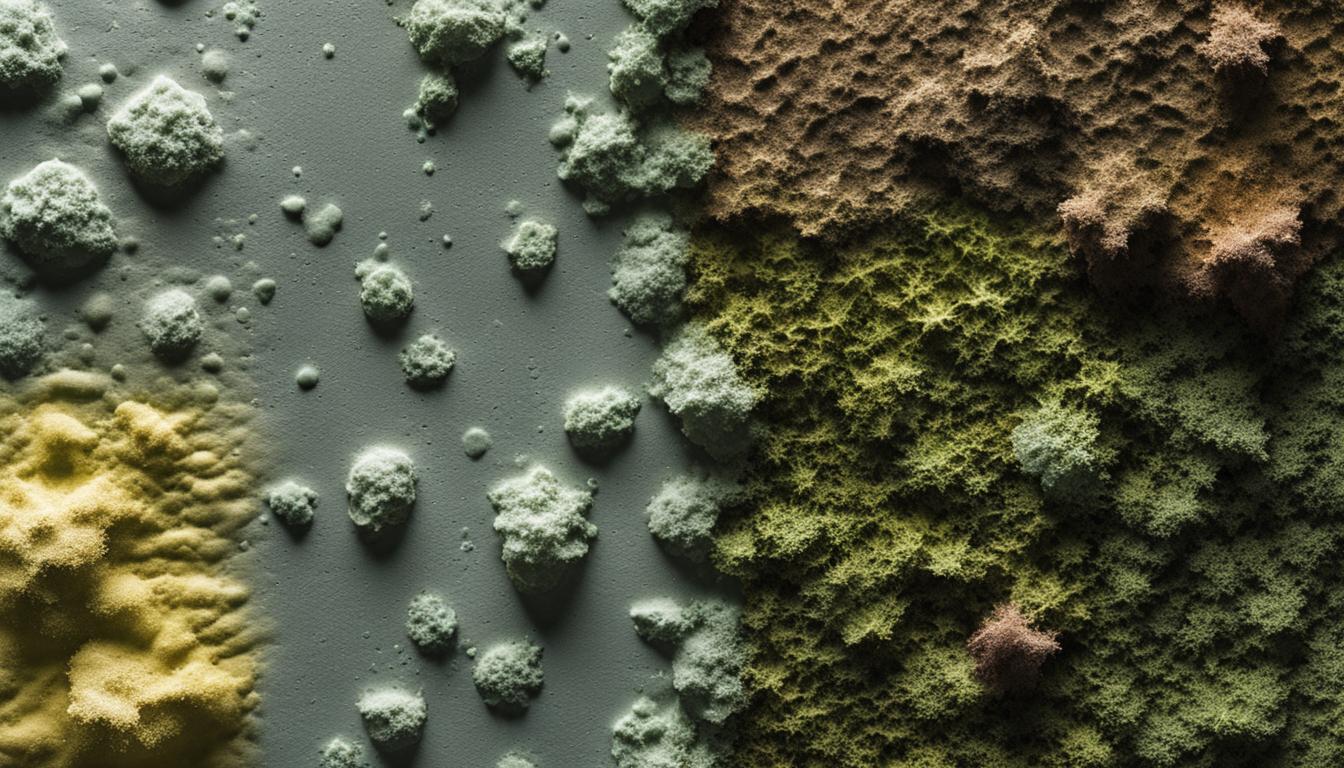If you’re concerned about the indoor air quality of your home, one question you may be asking is, “What is the most common type of mold?” Mold growth is a common issue in homes, and it can have significant health implications if left untreated. In this section, we’ll explore the most common type of mold found in homes and provide you with tips on how to identify and prevent it.
Key Takeaways
- The most common type of mold found in homes is Cladosporium.
- Effective mold prevention measures include controlling indoor humidity levels and improving ventilation.
- Early detection and mold removal is crucial to preventing potential health issues associated with mold growth.
- You can identify mold infestations by looking out for musty odors, discoloration, and visible patches.
- If you encounter mold issues in your home, it’s important to follow safe mold removal practices or seek professional help when necessary.
Understanding Mold Growth in Homes
Mold growth in homes can cause serious health problems and compromise indoor air quality. Understanding the conditions that promote mold growth is crucial in preventing infestations that can be costly and hazardous to your health.
The key condition for mold growth is moisture, which can come from various sources such as water leaks, dampness, and high humidity levels. Mold can grow on virtually any surface, including wood, drywall, fabrics, and carpeting.
To prevent mold growth, it is important to control moisture levels in your home. This can be achieved by regularly inspecting and repairing any water damage, ensuring proper ventilation in areas such as bathrooms and kitchens, and controlling humidity levels with the help of dehumidifiers and air conditioners.
Early detection of mold growth is also essential in preventing a small problem from turning into a full-blown infestation. Common signs of mold growth include musty odors and visible mold patches. If you suspect mold infestation in your home, prompt action is necessary.
Mold growth can have a significant impact on your indoor air quality, leading to respiratory problems and other health issues. By taking proactive measures to prevent mold growth and promptly addressing any infestations, you can ensure a healthy and safe indoor environment for you and your family.
The Most Common Type of Mold: Stachybotrys Chartarum
If you notice black mold in your home, it is likely to be Stachybotrys Chartarum. This is the most common type of mold found in homes, and it thrives in dark, damp places, such as bathrooms, basements, and kitchens.
Stachybotrys Chartarum is a toxic mold that can cause respiratory problems, headaches, fatigue, and other health issues. It typically appears as a black or greenish-black slimy substance and has a distinct musty odor. If you suspect that you have black mold in your home, it is essential to take action immediately to prevent its spread.
To help prevent the growth of Stachybotrys Chartarum, it is important to keep your home dry and well-ventilated. Fix any leaks or water damage promptly and use a dehumidifier in areas of your home that are prone to moisture.
Regularly inspecting your home for signs of mold growth, including discoloration and musty smells, can also help you identify the presence of black mold early, so you can take appropriate action to address the issue.
Identifying Mold Infestations
If left unchecked, mold infestations can cause serious health problems and structural damage to your home. The key to preventing these issues is early detection. Here are some signs of mold growth to be aware of:
- Musty odor: Mold has a distinct, unpleasant smell that can be hard to ignore. If you notice a musty scent in your home, it could be a sign of mold growth.
- Discoloration: Mold often appears as black, green, or white spots on walls, ceilings, and other surfaces. Keep an eye out for any unusual stains or discoloration in your home.
- Visible mold patches: If you can see mold growth in your home, it’s a clear sign that you have a problem that needs to be addressed immediately.
Even if you don’t see or smell anything unusual, it’s still a good idea to be vigilant about mold growth. Mold thrives in damp, humid environments, so it’s important to keep your home dry and properly ventilated.
If you do suspect that you have a mold infestation in your home, it’s important to take action right away. The longer you wait, the more difficult and expensive it will be to remediate the problem. In the next section, we’ll discuss some practical tips for preventing mold growth in the first place.
Preventing Mold Growth
Mold can be harmful to your health and cause damage to your home. The good news is that there are steps you can take to prevent mold growth:
- Keep indoor humidity levels below 60% by using dehumidifiers and air conditioning, especially in areas prone to moisture, such as bathrooms and kitchens.
- Ensure proper ventilation by using exhaust fans in bathrooms and kitchens, and opening windows when possible.
- Repair leaks promptly to prevent moisture buildup.
- Clean and dry any damp or wet areas within 24-48 hours to prevent mold growth.
- Use mold-resistant products in areas prone to moisture, such as drywall and paint.
- Regularly maintain your HVAC system and replace filters to ensure proper air flow.
- Consider using a mold prevention spray in areas prone to moisture or previous mold growth.
By following these mold prevention tips, you can help protect your health and your home.
Dealing with Mold Issues
It’s important to take mold issues seriously and deal with them promptly to avoid further damage. If you discover mold in your home, follow these mold removal tips:
- Assess the extent of the mold growth. If the moldy area is larger than 10 square feet, consider hiring a professional mold remediation service.
- If you decide to remove the mold yourself, wear protective gear including gloves, goggles, and an N-95 respirator mask.
- Seal off the area to prevent mold spores from spreading to other parts of your home.
- Remove all porous materials, such as drywall and carpeting, that have visible mold growth.
- Clean non-porous surfaces with a solution of one-part bleach to nine-parts water, or use a commercial mold removal product. Allow the surface to dry completely.
- Dispose of all moldy materials in heavy-duty plastic bags and seal tightly.
- After cleaning, ensure that the area is well-ventilated, and use a dehumidifier to reduce humidity levels and prevent future mold growth.
Remember, preventing mold growth is key to avoiding mold issues in the first place. Regularly inspect your home for signs of mold, and take steps to control moisture levels, ventilate properly, and fix any leaks or water damage promptly.
Conclusion
Now that you have a better understanding of mold and its impact on your home and health, it’s time to take action. Remember, early detection and prevention are key to avoiding mold infestations. Keep an eye out for the common signs of mold growth and take measures to prevent it from occurring in the first place.
Regular maintenance and proper ventilation can go a long way in keeping mold at bay. But if you do encounter mold issues, make sure to handle them safely and effectively. Always wear protective gear and follow proper procedures for mold removal.
By taking proactive steps to prevent mold growth and addressing any issues promptly, you can maintain a healthy indoor environment for you and your family. Stay vigilant and take care of your home, and it will take care of you.
FAQ
What are the most common types of mold found in homes?
The most common types of mold found in homes include Cladosporium, Penicillium, Aspergillus, and Stachybotrys Chartarum (also known as black mold).
How can I identify mold growth in my home?
Mold growth can be identified by visible signs such as discoloration, the presence of black or green patches, and a musty odor. If you suspect mold but can’t see it, you may also hire a professional to conduct mold testing.
What are the health risks associated with mold infestations?
Mold infestations can cause a variety of health issues, including allergic reactions, respiratory problems, and exacerbation of existing respiratory conditions such as asthma. It’s important to address mold promptly to ensure a healthy indoor environment.
How can I prevent mold growth in my home?
To prevent mold growth, it’s important to control indoor humidity levels, ensure proper ventilation in areas prone to moisture accumulation (such as bathrooms and kitchens), fix any water leaks promptly, and regularly clean and dry areas prone to moisture or condensation.
What should I do if I find mold in my home?
If you find mold in your home, it’s important to take immediate action to address the issue. Small areas of mold can be cleaned using a mixture of water and detergent. However, if the mold covers a large area (greater than 10 square feet) or if it is caused by extensive water damage, it is recommended to seek professional mold remediation services.
How can I safely remove mold from my home?
When it comes to removing mold, it’s important to take safety precautions to avoid exposure. Wear protective gear such as gloves and respiratory masks, contain the affected area to prevent the spread of spores, and use appropriate mold removal products or hire a professional mold remediation service.
When should I seek professional help for mold issues?
It is recommended to seek professional help for mold issues in the following situations: if the mold covers a large area (greater than 10 square feet), if it is caused by extensive water damage, if you have health concerns related to mold exposure, or if you are unsure about how to safely remove the mold yourself.
What are the key takeaways for preventing mold growth and maintaining a healthy indoor environment?
The key takeaways for preventing mold growth and maintaining a healthy indoor environment include controlling indoor humidity levels, addressing any water leaks or moisture issues promptly, ensuring proper ventilation, regularly cleaning and drying areas prone to moisture, and seeking professional help when necessary.






